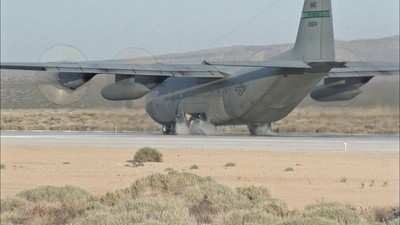Adding Stopping Power For A USAF Workhorse
Members of the 418th Flight Test Squadron C-130 Hercules Wheel
Brake System Improvement program at Edwards AFB are testing the
performance of carbon brakes and the new Mark IV Digital Antiskid
Control Unit for the aircraft to replace the C-130's legacy brake
system. Members of this test group said they know the lives of
current and future C-130 crewmembers depend on them doing their job
right.

"My primary objective is to make sure the carbon brakes and the
Mark IV are equivalent to or better than the legacy steel brakes
and the Mark II Analog Antiskid system," said Colin Young, a 418th
FLTS subsystems engineer. "If the tests are successful, then the
brakes will be retrofitted to all C-130s, other than the C-130J
(that already uses the new brakes)."
Parts for the current legacy brake system are becoming scarce
because they are no longer being manufactured, so the need for new
brakes is significant. The testing involves max-effort braking
where the pilot would apply the maximum pressure to the brakes to
stop the cargo plane. Different test points include observing how
the carbon brakes perform with different cargo weights and
wet-runway tests to evaluate the digital antiskid system.

Mr. Young said the carbon brakes are designed to have a
25-percent increase in thermal capacity when compared to the
current steel brakes, which reduces potential for brake fires and
locking up. The brakes also reduce stopping distance.
For testing purposes, team members drilled holes into the center
stator and inserted thermal probes into the brakes to obtain
real-time brake temperatures during testing. Test officials said
temperatures are essential to determine how hot the brakes get
during maximum effort braking and to evaluate the cooling profile
of the brakes.
"The one thing you find with steel brakes is they cannot handle
as much heat, and they certainly heat up a lot quicker than carbon
brakes," said 1st. Lt. Nicole Potter, a 418th FLTS flight test
engineer. "The nice thing about steel brakes is they dissipate the
heat quickly, and we're finding with the carbon brakes it takes a
little longer to cool, but their capacity to handle heat is a lot
better."
Along with better performance, the new carbon brakes are more
durable and efficient.
"From a logistics point of view, the old brakes can last up to
4,000 miles of landing distance," Mr. Young said. "The new brakes
can last 25,000 (miles), so it's almost six times better in terms
of logistics support." With C-130s doing constant missions
throughout Southwest Asia, a new braking system stands to benefit
cargo pilots down range and that fact is not lost on the test
team.
"The warfighters have had a continuous problem with the wear-out
of the brakes and the turnaround time to rebuild them," said Lance
Stoebling, assistant program manager.
"Composite brake systems are coming out throughout the Air Force
and the C-130 is next on the list." A C-130E on loan from the 19th
Airlift Wing at Little Rock Air Force Base, Ark. is being used to
accomplish testing and is scheduled to complete one last mission
for the Air Force before it is decommissioned. WBSI testing is
scheduled to conclude in July.
Since testing began in March, Mr. Stoebling said the 418th FLTS
has completed 100 percent of the legacy baseline brake testing and
about 75 percent of the new brake system tests.
"So far, it looks very promising," said Mr. Stoebling. [ANN
Salutes Kenji Thuloweit, 95th Air Base Wing Public Affairs]
 ANN's Daily Aero-Term (04.24.24): Runway Lead-in Light System
ANN's Daily Aero-Term (04.24.24): Runway Lead-in Light System ANN's Daily Aero-Linx (04.24.24)
ANN's Daily Aero-Linx (04.24.24) Aero-FAQ: Dave Juwel's Aviation Marketing Stories -- ITBOA BNITBOB
Aero-FAQ: Dave Juwel's Aviation Marketing Stories -- ITBOA BNITBOB Classic Aero-TV: Best Seat in The House -- 'Inside' The AeroShell Aerobatic Team
Classic Aero-TV: Best Seat in The House -- 'Inside' The AeroShell Aerobatic Team Airborne Affordable Flyers 04.18.24: CarbonCub UL, Fisher, Affordable Flyer Expo
Airborne Affordable Flyers 04.18.24: CarbonCub UL, Fisher, Affordable Flyer Expo




